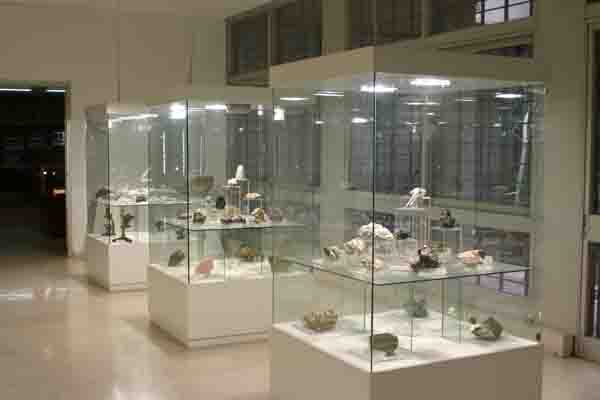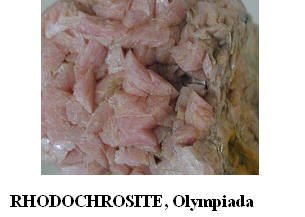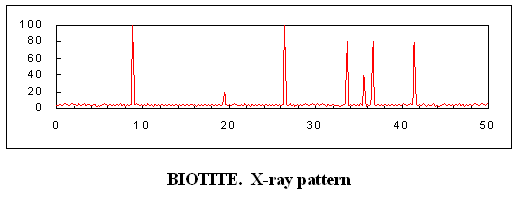The Mineralogy and Petrology Museum occupies a total area of about 1100 m2. The collections are exhibited in the first three halls with dimensions of 10 x 8, 13 x 8 and 33 x 20 metres respectively, while the fourth hall is for audio-visual presentations and lectures, and is 17 x 8 m. .
The Museum also has areas for its laboratory, offices and storage space, which are not open to the public
The first hall creates a feeling of admiration in the visitor because it is adorned with seven modern crystal cases, lighted internally, in which mineral samples of high aesthetic value are presented, some of which are among the most beautiful of their kind. These cases were lent by the Greek Association of Mineral and Fossil Collectors. Explanatory texts provide information about related subjects.

The first two display cases are given over to minerals from the Lavrion mines
LAVRION: The broader mining region of Lavreotiki constitutes a natural museum, since in it can be found more than 15% of all the recognised minerals on earth, known world-wide for their variety and for their particular beauty.
The great mining boom of Lavrion began in 483 BC, when the rich deposits of silver were discovered in Maronia (today’s Kamariza). The silver that at that period “flowed like water from the spring” came from the silver mines, the famous arghyreia, from which the state and businessmen made astronomical profits in the fifth century. It is reported that a certain Kallias earned 1,200,000 drachmas (5.5 tons of silver) in one year
The ancient, underground galleries extend over a total length of hundreds of kilometres and were built on six levels. More than 1000 shafts have been found in the region, some of which are as deep as 119 metres
The galleries were hewn out using nothing but pickaxes, hammers and chisels. Fire was used to a lesser degree where explosives would be utilised today. That is, the rock would be heated, and then water was thrown on it suddenly, causing the rock to shatter owing to the abrupt contraction. It is calculated that the work of building a gallery proceeded at a rate of 12 metres a month, while for shafts the rate was just five metres a month
Using Lavrion silver, Themistocles was able to build the powerful Athenian fleet, which together with that of the rest of Greece, saved the ancient civilisation at the battle of Salamis. The Athenian triremes then numbered 200, out of a total of 314 in Greece. Every trireme cost two talents, which were equivalent to 54 kg of silver. Before the Peloponnesian war, 270 tons of silver were stored in the treasury of the Parthenon and as much again was in circulation as coinage.

During antiquity, the mines belonged exclusively to the Athens city-state, which granted concessions to exploit them primarily to Athenian private citizens. The concessionaire would hand over one-twentieth of his profits to the state. At the period of maximum activity, this amounted to 50-100 talents a year (1 talent = 27 kg silver or 6.000 silver drachmas).
State control of the operation of the mines and of their production was systematic and strict. For this reason there was a special mining law and a special court to enforce it. Anyone would be punished who exceeded the limits of his concession, operated the mine that had been ceded to him in an irregular way, or jeopardised the future of other mines. It is reported that under Lycurgus (330 BC), a certain Diphilos, known for the large profits he extracted from Lavrion, was put to death for his greed, because he cut down the mineral columns that were left intact to prop up the galleries.
One case contains metallic minerals from Greece and abroad.
METALLIC MINERALS: Included in this category are native metals or compounds of metals, with sulphur, arsenic, oxygen and other elements. When a concentration or paragenesis of minerals is enriched with certain critical components making its exploitation financially profitable, then it is described as a deposit. On the contrary, when the concentration of crucial components is limited in extent or content so that it is not exploitable, it is then called an occurrence.
A metalliferous or metal-bearing deposit is one from which metals or combinations of metals useful in metallurgy can be extracted. The mineral components of the deposit constitute the ore. Exploiting such a concentration of minerals depends not only on the characteristics of its occurrence, but also on other factors that can change according to the circumstances, such as the cost of extraction, international prices, supply and demand, as well as political factors.

There is a wide variety of deposits in Greece, but primarily occurrences, of several metal-bearing minerals, such as iron (Serifos, Plaka Lavrion, Grammatiko Attica, Thasos), chromium (Vourinos, Pharsala, Domokos), nickel (Lokrida, Evvia, Parnitha, Skyros), manganese (Drama, Chalkidiki, Paros, Messinia), molybdenum (Axioupoli, Drama, Xanthi, Lesbos), aluminium (the bauxites of Parnass, Domokos, Euboea, Mandra Attica), magnesium (Vavdos Chalkidiki, Mantoudi and Limni Euboea) copper (Argolida, Phthiotida, Grevena, Chalkidiki), lead (Lavrion, Chalkidiki, Alexandroupoli), antimony (Lahanas, Thessaloniki, Chios), gold (Pangaeus, Chalkidiki, Euboea), silver (Lavrion, Chalkidiki, Thasos, Alexandroupoli, Kilkis) and uranium (Drama, Kilkis, Xanthi, Serres).
Carbonate and silicate (rock-forming) minerals from Greece and abroad are presented in two display cases
Carbonate minerals are those containing the CO3-2 ion. The most common minerals of this group are calcite and aragonite. Though both minerals have the formula [CaCO3], they have different structures (calcite crystallizes in the trigonal while aragonite crystallizes in the orthorhombic system). That is why they are called polymorphs (=multi-forms).
Calcite is a common mineral, being the main constituent of limestone and marble, rocks prevailing in Greece. It presents a large variety of crystal aggregates and colors. Transparent rhombohedral crystals are called Iceland spar. Most stalactites consist of aragonite.
Limestone, a sedimentary rock consisting almost entirely of calcite, is an important industrial material, as it is the main row material for cement (75% CaCO3). It is also used for the production of quicklime after heating in furnaces at 880 °C, or crushed (aggregate for concrete, railroads etc).
Marble, a metamorphic rock also consisting almost entirely of calcite, is used for floor plating and facade coatings. It is also the main row material for sculpture. Island spar is used in optical instruments.
Other carbonate minerals are rhodochrosite [MnCO3], its name deriving from its pink color and magnesite [(MgCO3], an industrial mineral used for firebrick manufacture. Beautiful samples of crystalline rhodochrosite have been found at Olympiada mine, Chalkidiki, while magnesite ores exist at Mandoudi, Euboea and Vavdos, Chalkidiki.

This mineral group comprises also the impressive, esthetical minerals smithsonite [ZnCO3], malachite [Cu2CO3(OH)2] and azurite [Cu2(CO3)2(OH)2]. Excellent samples of these minerals have been found in Lavreotiki area.
A common characteristic of the carbonate minerals is the fermentation when they get in contact with hydrochloric acid, due to the formation of CO2 bubbles. Especially calcite and aragonite present very strong fermentation even when affected by cold, weak hydrochloric acid.
ROCK FORMING MINERALS: Rocks are formed on the solid crust of the earth, i.e. on its thin outer shell that covers the mantle, which is the intervening layer that surrounds the core of the Earth. The proportional thickness of these three layers is about 1 (crust): 72 (mantle): 86 (core).
Observing a rock, either with our eyes or under a microscope, we can see that it consists of large and small grains, which frequently differ among themselves. These grains are minerals.
The first systematic study of minerals was written in 315 BC by Theophrastus, pupil of Aristotle’s. His five-volume work “On Stones”, of which just one volume has been preserved, was in essence the only original book on mineralogy up to the Middle Ages.

Of the 3500 known minerals, only about 30 are significant components of rocks and are called “rock-forming minerals”. Most of these contain silicon, i.e. they belong to the group of silicates. The minerals found most frequently in the earth’s crust are feldspars (composed of potassium, sodium, calcium, aluminium and silicon) and quartz (silicon oxide).
A mineral may be found in a variety of forms. For example, rubies, sapphires and corundum are different forms of aluminium oxide.
Another example of the variety possible is quartz, which can be found in a wide range of colours, e.g. yellow (citrine), violet (amethyst), green (prasio), transparent colourless (rock crystal) or banded (agate).

The study of minerals through a x-ray spectroscope is the most accurate way of identifying them, because the spectrum (pattern) of a mineral is as unique as a human fingerprint.
In the last two display cases, there are world-class samples of minerals and gemstones from the former Soviet Union. These samples cover a very wide range of minerals extracted during the last century, mainly from the region of the Urals.
MINERALS FROM THE URALS: The Ural Mountains (“rock zone” in the Tartar language) form a natural boundary between Europe and Asia. It is a range that was created when the tectonic plates of Siberia and Eastern Europe collided during the Hercynian orogeny about 300 million years ago.
The Urals region is a vast mineral museum with more than 800 different types of minerals and more than 12,000 sites rich in collector’s minerals in its central section alone.
During the geological evolution of the Urals, a multitude of deposits and mineral occurrences were created. Particularly typical are the deposits of platinum, asbestos, talc and chromite, of which we have unique samples such as lumps of platinum, chromium titanite and uvarovite.

Typical minerals from the Urals are: malachite, azurite and cuprite from the region of Nishne Tagil, diopside, garnet, clinochlore, vesuvian and perovskite from the magnetite deposits at Achmatovsk in the Slatoust region, and excellent samples of native gold and crocoite from Beresovsk, near the city of Ekaterinburg.
From the mineralogical viewpoint, there are famous beds of precious stones as well as rare minerals. The best known are at Malyshevo, in the Takovaya region, from which are derived splendid specimens of emerald, alexandrite and phenakite, the Mursinka-Adui region, known for its pegmatites, rich in topaz, tourmaline and beryl, and the Ilmen mountain region in Miask, with unrivalled samples of sapphire, zircon, cancrinite, sodalite, amazonite and ilmenite. The central Urals are also known for occurrences of ornamental minerals such as rhodonite, jasper and agate.
Although the first diamonds were not discovered in the Western Urals until 1823, today there are many occurrences of diamonds in the former Soviet Union, in the Kola peninsula and Kamtchaka in Ukraine, in Kazakstan and in Sakha, Siberia.
The second hall is mainly of a teaching nature. In three built-in display cases, samples and explanatory texts are presented to enable the viewer to understand the concepts of minerals, rocks, ores and industrial minerals. In a special case devoted to meteorites, a sample of iron meteorite found in Argentina is displayed.
METEORITES: Most people are familiar with the term “falling stars”, but few are aware that it isn’t a star that’s falling but a piece of solid matter from space that has entered the Earth’s atmosphere and become overheated due to friction. If this body does not disintegrate when entering the atmosphere and falls onto the earth’s surface, it will be a meteorite
According to their composition, meteorites are subdivided into three categories: iron, stony and stony iron meteorites. The main components of meteorites are alloys of iron, nickel and silicates; they may also contain smaller quantities of other minerals.

Tectites are materials of controversial origin. One view considers them to be matter from Mars or the Moon. They are, in fact, usually terrestrial rocks that have melted owing to the high temperatures developed during the fall of a meteorite. The best known tectites are moldavites. Tectites usually appear in a characteristic form, which is the shape of a disk or teardrop
On the eastern side of the hall a darkened room has been set up to display the luminescence of minerals. This is one of the largest collections in Europe, which demonstrates the fluorescence and phosphorescence of minerals by using ultraviolet lamps with different wavelengths.
In the third hall, the visitor encounters the heavy wooden display cases of the 19th century. The walls are covered by high upright cases, while inside the hall there are also low cases in which the systematic collection is found. The decoration of the second hall is fully in harmony with the Museum’s exhibits, most of which can be dated from the 19th century.

This hall includes six sections.
a) the systematic collection of minerals,
b) thematic collections of minerals,
c) collections of precious stones, minerals and ornamental rock,
d) petrographic and ores collections,
e) crystallographic collections, and
f) a special display about the Santorini volcano.
